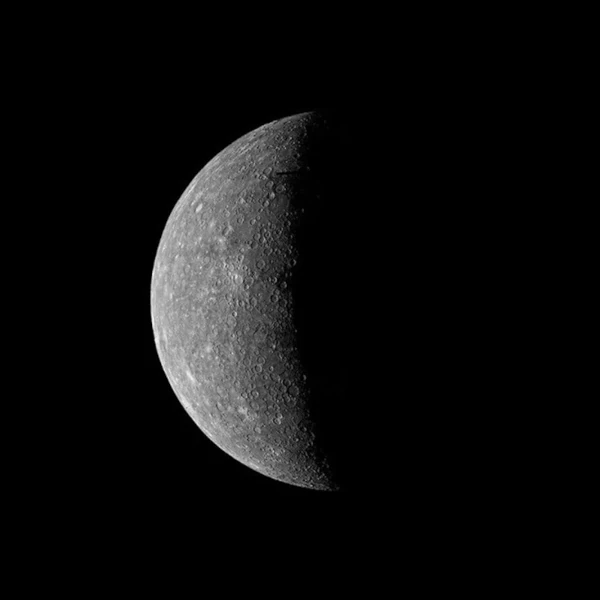
Mercury, the first planet of the solar system, is located at an average distance of \( 57.9 \times 10^6 \, \text{km} \) from the Sun. With a diameter of only \( 4,879 \, \text{km} \), it is smaller than Jupiter's moon, Ganymede. However, its average density, \( 5.43 \, \text{g/cm}^3 \), rivals that of Earth, suggesting a metallic core occupying more than 70% of its total radius.
Mercury, the closest planet to the Sun, presents one of the most fascinating paradoxes in our solar system. Although located only 58 million kilometers from our star, this small rocky planet hosts such extreme contrasts that it fully deserves its title of "world with two faces".
The first face of Mercury is that of an infernal furnace. During the Mercurian day, when the Sun directly strikes its surface, temperatures can reach scorching highs of 430°C. This heat, sufficient to melt lead and zinc, transforms the surface into a burning and desolate landscape.
The second face is that of a cosmic freezer. When night falls on Mercury, in the absence of a significant atmosphere to retain heat, temperatures plummet to -180°C. This thermal difference of over 600 degrees between day and night is the largest in the entire solar system.
| Aspect | Day Side | Night Side | Difference |
|---|---|---|---|
| Temperature | +430°C | -180°C | 610°C |
| Duration | 88 Earth days | 88 Earth days | Full cycle: 176 days |
| Conditions | Intense solar radiation | Deep space cold | Opposite environments |
| Phenomena | Metal melting | Water ice in craters | Thermal paradox |
Source: NASA Solar System Exploration - Mercury and ESA BepiColombo Mission.
This extreme phenomenon is mainly explained by the almost total absence of an atmosphere. Unlike Earth, which benefits from an atmosphere acting as a thermal blanket, Mercury only has a tenuous exosphere, unable to redistribute heat or moderate temperatures.
| Element/Gas | Symbol | Relative Abundance | Main Origin |
|---|---|---|---|
| Oxygen | O | 42% | Surface outgassing |
| Sodium | Na | 29% | Surface rock vaporization |
| Hydrogen | H | 22% | Solar wind |
| Helium | He | 6% | Radioactive decay + solar wind |
| Potassium | K | ~0.5% | Rock vaporization |
| Calcium | Ca | ~0.5% | Rock vaporization |
The most surprising paradox was discovered in the 1990s by the Mariner 10 probe and later confirmed by Messenger: the presence of water ice in polar craters permanently in shadow. These areas, never reached by direct sunlight, maintain temperatures below -160°C, allowing ice to persist despite the proximity to the Sun.
Mercury's particular rotation contributes to these extremes. The planet completes three rotations on its axis for every two revolutions around the Sun, a phenomenon of spin-orbit resonance that exposes certain regions to solar rays for longer periods.
N.B.:
The 3:2 resonance represents a stable minimum energy state. Any deviation would be corrected by tidal forces, making this state the natural equilibrium for Mercury. This configuration is unique among the planets of the solar system.
Mercury's rotation was long misunderstood. Until 1965, it was thought that it always presented the same face to the Sun, like the Moon with Earth. Radar observations by Gordon Pettengill (1926-2021) and his team revealed the true rotation period.
This particular rotation has concrete effects on Mercury:
Our understanding of this world of contrasts owes much to dedicated space missions:
N.B.:
Mercury's 3:2 spin-orbit resonance means it rotates three times on its axis while completing two full orbits around the Sun. This unique phenomenon creates Mercurian "solar days" that last 176 Earth days.
| Mission | Agency | Dates | Status | Main Discoveries |
|---|---|---|---|---|
| Mariner 10 | NASA | 1974-1975 | Completed | First close-up images, magnetic field, cratered surface |
| MESSENGER | NASA | 2011-2015 | Completed | Complete mapping, polar ice, surface composition |
| BepiColombo | ESA/JAXA | 2018-present | Ongoing | Magnetosphere study, composition, internal structure |
| Mercury-P | Roscosmos | Proposed | Cancelled | Joint Russia-Europe mission never realized |
Classical planetary formation models struggle to explain Mercury's extreme composition. Several hypotheses coexist: a giant impact that stripped part of its mantle, intense evaporation during the first millions of years of the protoplanetary disk, or accretion from metallic materials enriched by the young Sun.
The isotopes of potassium and sulfur detected by MESSENGER show, however, that Mercury has not undergone massive loss of volatiles, contradicting the idea of a body "cooked" by the Sun. This paradox, studied by Sean Solomon (1945- ), demonstrates that the smallest planet in the solar system remains the most puzzling.